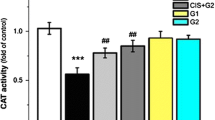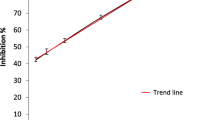Abstract
Cisplatin is broadly used in the treatment of malignancies. However, the high incidence of nephrotoxicity following cisplatin use deters its clinical utility. Former studies have shown that the essential oils, obtained from Citrus limonia demonstrated significant anti-inflammatory and antioxidant effects. The aim of the current work was to evaluate the protective effects of Citrus limonia oil against cisplatin-induced nephrotoxicity. Thirty-two adult male mice were divided into four groups, eight mice each. The control group received distilled water, and the second group received a single intraperitoneal injection of cisplatin (20 mg/kg), while the third and fourth groups received cisplatin plus Citrus limonia oil at 100 or 200 mg/kg for 10 days, respectively. GC-MS analysis showed that the major components in Citrus limonia oil were d-limonene, 5-methyl-pentadecane, (n)-menthol, 3,7-dimethyl-(E)-2,6-octadienal, 3,7-dimethyl-2,6-octadienal, and nonadecane. Biochemical analysis showed that cisplatin intoxication was associated with significantly increased (p < 0.05) serum levels of urea and creatine and pro-inflammatory cytokines, as well as augmented renal tissue oxidative stress. Light microscopic examination showed loss of renal architecture, atrophied glomeruli, interstitial hemorrhage, dilated cortical tubules with cast formation, and excessive collagen production. Electron microscopic examination revealed compressed and karyorrhectic endothelial nuclei with chromatin condensation in the glomeruli, accumulation of mesangial matrix, and obliteration of glomerular blood capillaries. Co-administration of Citrus limonia oil attenuated these effects in renal histopathological, morphometric, and ultrastructural examinations, frequently in a dose-dependent manner. In conclusion, Citrus limonia oil can ameliorate the toxic effect of cisplatin on mice kidneys, probably through its antioxidant and anti-inflammatory effects.





Similar content being viewed by others

References
Abdel-Daim MM, Ahmed A, Ijaz H, Abushouk AI, Ahmed H, Negida A, Aleya L, Bungau SG (2019a) Influence of Spirulina platensis and ascorbic acid on amikacin-induced nephrotoxicity in rabbits. Environ Sci Pollut Res 26:8080–8086
Abdel-Daim MM, Aleya L, El-Bialy BE, Abushouk AI, Alkahtani S, Alarifi S, Alkahtane AA, AlBasher G, Ali D, Almeer RS (2019b) The ameliorative effects of ceftriaxone and vitamin E against cisplatin-induced nephrotoxicity. Environ Sci Pollut Res 26:15248–15254
Aebi H (1984) Catalase in vitro, methods in enzymology. Elsevier, pp:121–126
Amorim JL, Simas DLR, Pinheiro MMG, Moreno DSA, Alviano CS, da Silva AJR, Fernandes PD (2016) Anti-inflammatory properties and chemical characterization of the essential oils of four citrus species. PLoS One 11:e0153643
Bancroft JD, Cook HC (1994) Manual of histological techniques and their diagnostic application. Churchill Livingstone
Beutler E (1963) Improved method for the determination of blood glutathione. J Lab Clin Med 61:882–888
Calado A (2013) Introduction to the renal histopathology the glomerular evaluation by routine optic microscopy. Experimental Pathology and Health Sciences 7:19–24
Chirino YI, Pedraza-Chaverri J (2009) Role of oxidative and nitrosative stress in cisplatin-induced nephrotoxicity. Exp Toxicol Pathol 61:223–242
Coulombe J, Favreau L (1963) A new simple semimicro method for colorimetric determination of urea. Clin Chem 9:102–108
Erdinç M, Erdinç L, Nergiz Y, Kelle İ (2007) The effects of nifedipine on renal perfusion pressure and kidney during cisplatin-induced nephrotoxicity in rats. Dicle Tıp Dergisi 34:248–253
Frazier KS, Seely JC, Hard GC, Betton G, Burnett R, Nakatsuji S, Nishikawa A, Durchfeld-Meyer B, Bube A (2012) Proliferative and nonproliferative lesions of the rat and mouse urinary system. Toxicol Pathol 40:14S–86S
Gulec M, Iraz M, Yilmaz HR, Ozyurt H, Temel I (2006) The effects of ginkgo biloba extract on tissue adenosine deaminase, xanthine oxidase, myeloperoxidase, malondialdehyde, and nitric oxide in cisplatin-induced nephrotoxicity. Toxicol Ind Health 22:125–130
Ibrahim A, Al-Hizab FA, Abushouk AI, Abdel-Daim MM (2018) Nephroprotective effects of benzyl isothiocyanate and resveratrol against cisplatin-induced oxidative stress and inflammation. Front Pharmacol 9:1268
Kamel KM, El-Raouf A, Ola M, Metwally SA, El-Latif A, Hekma A, El-sayed ME (2014) Hesperidin and rutin, antioxidant citrus flavonoids, attenuate cisplatin-induced nephrotoxicity in rats. J Biochem Mol Toxicol 28:312–319
Kummer R, Fachini-Queiroz FC, Estevão-Silva CF, Grespan R, Silva EL, Bersani-Amado CA, Cuman RKN (2013): Evaluation of anti-inflammatory activity of Citrus latifolia Tanaka essential oil and limonene in experimental mouse models Evidence-Based Complementary and Alternative Medicine 2013
Larsen K (1972) Creatinine assay by a reaction-kinetic principle. Clin Chim Acta 41:209–217
Liu KD, Brakeman PR (2008) Renal repair and recovery. Crit Care Med 36:S187–S192
Martinez G, Costantino G, Clementi A, Puglia M, Clementi S, Cantarella G, De Meo L, Matera M (2009) Cisplatin-induced kidney injury in the rat: L-carnitine modulates the relationship between MMP-9 and TIMP-3. Exp Toxicol Pathol 61:183–188
Miller RP, Tadagavadi RK, Ramesh G, Reeves WB (2010) Mechanisms of cisplatin nephrotoxicity. Toxins 2:2490–2518
Misharina T, Samusenko A (2008) Antioxidant properties of essential oils from lemon, grapefruit, coriander, clove, and their mixtures. Appl Biochem Microbiol 44:438–442
Nishikimi M, Rao NA, Yagi K (1972) The occurrence of superoxide anion in the reaction of reduced phenazine methosulfate and molecular oxygen. Biochem Biophys Res Commun 46:849–854
Paglia DE, Valentine WN (1967) Studies on the quantitative and qualitative characterization of erythrocyte glutathione peroxidase. J Lab Clin Med 70:158–169
Rabik CA, Dolan ME (2007) Molecular mechanisms of resistance and toxicity associated with platinating agents. Cancer Treat Rev 33:9–23
Ramadan LA, El-Habit OH, Arafa H, Sayed-Ahmed MM (2001) Effect of cremophor-el on cisplatin-induced organ toxicity in normal rat. J Egyptian Nat Cancer Inst 13:139–145
Ramesh G, Reeves WB (2003) TNFR2-mediated apoptosis and necrosis in cisplatin-induced acute renal failure. American Journal of Physiology-Renal Physiology 285:F610–F618
Ravindra P, Bhiwgade A, Kulkarni S, Rataboli PV, Dhume CY (2010) Cisplatin induced histological changes in renal tissue of rat. Journal of Cell and Animal Biology 4:108–111
Rehman MU, Tahir M, Khan AQ, Khan R, Oday-O-Hamiza LA, Hassan SK, Rashid S, Ali N, Zeeshan M (2014) D-Limonene suppresses doxorubicin-induced oxidative stress and inflammation via repression of COX-2, iNOS, and NFκB in kidneys of Wistar rats. Exp Biol Med 239:465–476
Ridnour LA, Sim JE, Hayward MA, Wink DA, Martin SM, Buettner GR, Spitz DR (2000) A spectrophotometric method for the direct detection and quantitation of nitric oxide, nitrite, and nitrate in cell culture media. Anal Biochem 281:223–229
Santos N, Catao C, Martins N, Curti C, Bianchi MLP, Santos AC (2007) Cisplatin-induced nephrotoxicity is associated with oxidative stress, redox state unbalance, impairment of energetic metabolism and apoptosis in rat kidney mitochondria. Arch Toxicol 81:495–504
Santos N, Bezerra CC, Martins N, Curti C, Bianchi M, Santos A (2008) Hydroxyl radical scavenger ameliorates cisplatin-induced nephrotoxicity by preventing oxidative stress, redox state unbalance, impairment of energetic metabolism and apoptosis in rat kidney mitochondria. Cancer Chemother Pharmacol 61:145
Schrier RW (2002) Cancer therapy and renal injury. J Clin Invest 110:743–745
Sood S, Muthuraman A, Gill N, Bali M, Sharma P (2010) Effect of Citrus karna peel extract on stress induced peptic ulcer in rat. J Biol Sci 10:231–236
Uchiyama M, Mihara M (1978) Determination of malonaldehyde precursor in tissues by thiobarbituric acid test. Anal Biochem 86:271–278
Ullah N, Khan MA, Khan T, Ahmad W (2014) Nephroprotective potentials of Citrus aurantium: a prospective pharmacological study on experimental models. Pak J Pharm Sci 27:505–510
Vickers AE, Rose K, Fisher R, Saulnier M, Sahota P, Bentley P (2004) Kidney slices of human and rat to characterize cisplatin-induced injury on cellular pathways and morphology. Toxicol Pathol 32:577–590
Zeisberg M, Kalluri R (2004) The role of epithelial-to-mesenchymal transition in renal fibrosis. J Mol Med 82:175–181
Acknowledgments
This project was supported by King Saud University, Deanship of Scientific Research, College of Science Research Center.
Funding
This project was supported by King Saud University, Deanship of Scientific Research, College of Science Research Center.
Author information
Authors and Affiliations
Corresponding author
Ethics declarations
Conflict of interest
The authors declare that they have no conflict of interest.
Additional information
Responsible editor: Philippe Garrigues
Publisher’s note
Springer Nature remains neutral with regard to jurisdictional claims in published maps and institutional affiliations.
Electronic supplementary material
ESM 1
(PDF 5309 kb)
Rights and permissions
About this article
Cite this article
Abdel-Daim, M.M., Mahmoud, O.M., Al Badawi, M.H. et al. Protective effects of Citrus limonia oil against cisplatin-induced nephrotoxicity. Environ Sci Pollut Res 27, 41540–41550 (2020). https://doi.org/10.1007/s11356-020-10066-x
Received:
Accepted:
Published:
Issue Date:
DOI: https://doi.org/10.1007/s11356-020-10066-x



